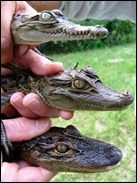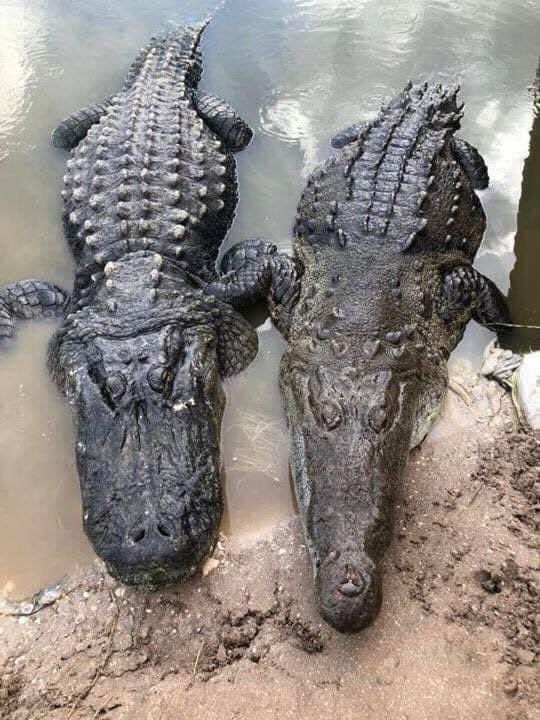What’s the difference between a caiman, crocodile and alligator?
Posted By RichC on March 10, 2019
Personally I’m not fond of any of the water, swamp or land creatures with teeth and jaws that look prehistoric … but all crocodilian (photo left, caiman, crocodile, alligator) definitely keep me on my toes, especially those bigger ones when visiting areas where they  live (in our case, the southeastern US).
live (in our case, the southeastern US).
My first exposure with an alligator was when my grandparents brought my brother and I taxidermized alligators from their winter in Florida back in the 1960s (I wish I still had them). A more memorable encounter was when stopping for a picnic outside the entrance to the Okefenokee Swamp with my parents as kids when traveling. My brother and I regularly enjoyed the  chance to run around while waiting for mom to make lunch on the tailgate of the station wagon and enjoyed poking ponds with sticks to see if we could find small alligators. After eating lunch, we walked back from the picnic table around the side of the car and came face to face with a BIG gator … likely wondering why we were poking for her offspring (or more likely like all wildlife, looking for handouts). Whew … our hearts skipped a beat as we quickly jumped in the other car door.
chance to run around while waiting for mom to make lunch on the tailgate of the station wagon and enjoyed poking ponds with sticks to see if we could find small alligators. After eating lunch, we walked back from the picnic table around the side of the car and came face to face with a BIG gator … likely wondering why we were poking for her offspring (or more likely like all wildlife, looking for handouts). Whew … our hearts skipped a beat as we quickly jumped in the other car door.
But back to the difference between alligators, crocodiles and the smaller central and South American caiman.
Here are a three “glaring” differences:
- Snout shape: Alligators have wider, U-shaped snouts, while crocodile front ends are more pointed and V-shaped.
- Toothy grin: When their snouts are shut, crocodiles look like they’re flashing a toothy grin,
as the fourth tooth on each side of the lower jaw sticks up over the upper lip. For alligators, the upper jaw is wider than the lower one, so when they close their mouths, all their teeth are hidden.
- Home base: Crocodiles tend to live in saltwater habitats, while alligators hang out in freshwater marshes and lakes.
But here are 8 differences …
That final “home base” difference is why crocodiles can be a bigger concern for those cruising/sailing down-under and in areas of the South Pacific and Indian Ocean.
Lingual salt glands: Crocodiles and gharials also differ from alligators and caimans in having functioning salt glands on their tongue. Structurally, these are actually modified salivary glands, and while alligators and caimans also have these structures they appear to have lost the ability to use them for excreting significant amounts of salt. This makes crocodiles more tolerant to life in saline water, including sea water in some species. Moreover, it suggests that crocodiles have a more recent marine ancestry: the ability to migrate across wide marine bodies, and even live there for extended periods, would certainly explain their current wide distribution across different continents. If ancestral species could live in marine environments, this ability has not been completely lost in modern crocodiles. Species such as saltwater crocodiles (C. porosus) can survive for extended periods in tidal estuaries, around the coast, and even out to sea. Alligators and caimans have lost much of this osmotic ability to secrete excess salt through the tongue glands, and can only tolerate it for short periods of time, prefering to remain in freshwater areas when possible. However, it is not unknown for large alligators to find their way into tidal mangroves and very rarely into coastal areas.

Comments